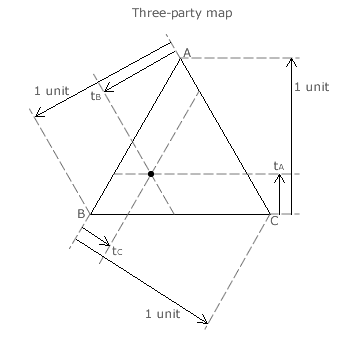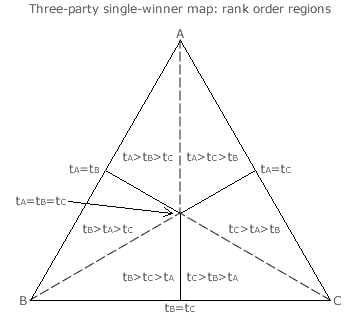Evaluations: Diagrams and Maps 4
Three-Party Maps

For three parties, a two-dimensional map is required. An equilateral triangle is ideal for a three-party map as it treats all three parties equally; see opposite. Triangles also have a key property for any point within them. Let the minimum distance from each side (base) to the point be tX (in the direction towards apex X) where this distance is expressed as a proportion of the height (1 unit). Then, for any point in any triangle, the sum of these three distances equals unity.
As the sum of the three tally shares must also equal unity, then each such distance can represent one of these three tally shares. The point on the map hence represents the election outcome in terms of the share of the tallies. Every possible outcome is therefore represented by the relevant point somewhere on the map.
The tally share for party A is tA units towards its apex A from the opposing base BC. The shares tB and tC are similarly defined. These shares therefore identify the sole point on the map that represents this unique tally share ratio (tA:tB:tC). Notice that any two of the three shares are sufficient to locate this point as the third share is necessarily the remaining one. Like the three shares, the three distances that represent them sum to unity. Each dashed line on this map indicates that all the points along it have a common value for one of the shares. For example, all the points along the horizontal dashed line have a tally share of tA.

In the three-party single-winner map shown opposite, the central point represents the critical tie between the three candidates as each has one third of the vote. Inside the triangle, each full line defines a two-way tie for first place and a dashed one a two-way tie for second place. Within each of the six regions, all the points and the tally share ratios that they represent yield the same rank order outcome. For example, in the region where tA > tB > tC, every point is nearest apex A then B and then C so the rank order is A B C.
For multiple-winner maps, the number of rank order regions increases and their average size correspondingly decreases. Party stick diagrams are used to identify all the relevant two-way and three-way ties that form the region boundaries.
Maps for Larger Numbers of Parties
For each additional party, an extra dimension is required to map the party tallies. A three-dimensional model of a tetrahedron is hence needed as a four-party (S = 4) map. A tetrahedron is a solid object with four identical equilateral triangles as its faces. Conventional mapping is clearly not possible for more than four parties as more than three dimensions are required. Therefore, in practice, mapping is normally restricted to just two or three parties.
Proceed to next page > Evaluations: Diagrams & Maps 5
Return to previous page > Evaluations: Diagrams & Maps 3
